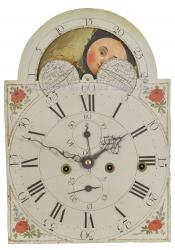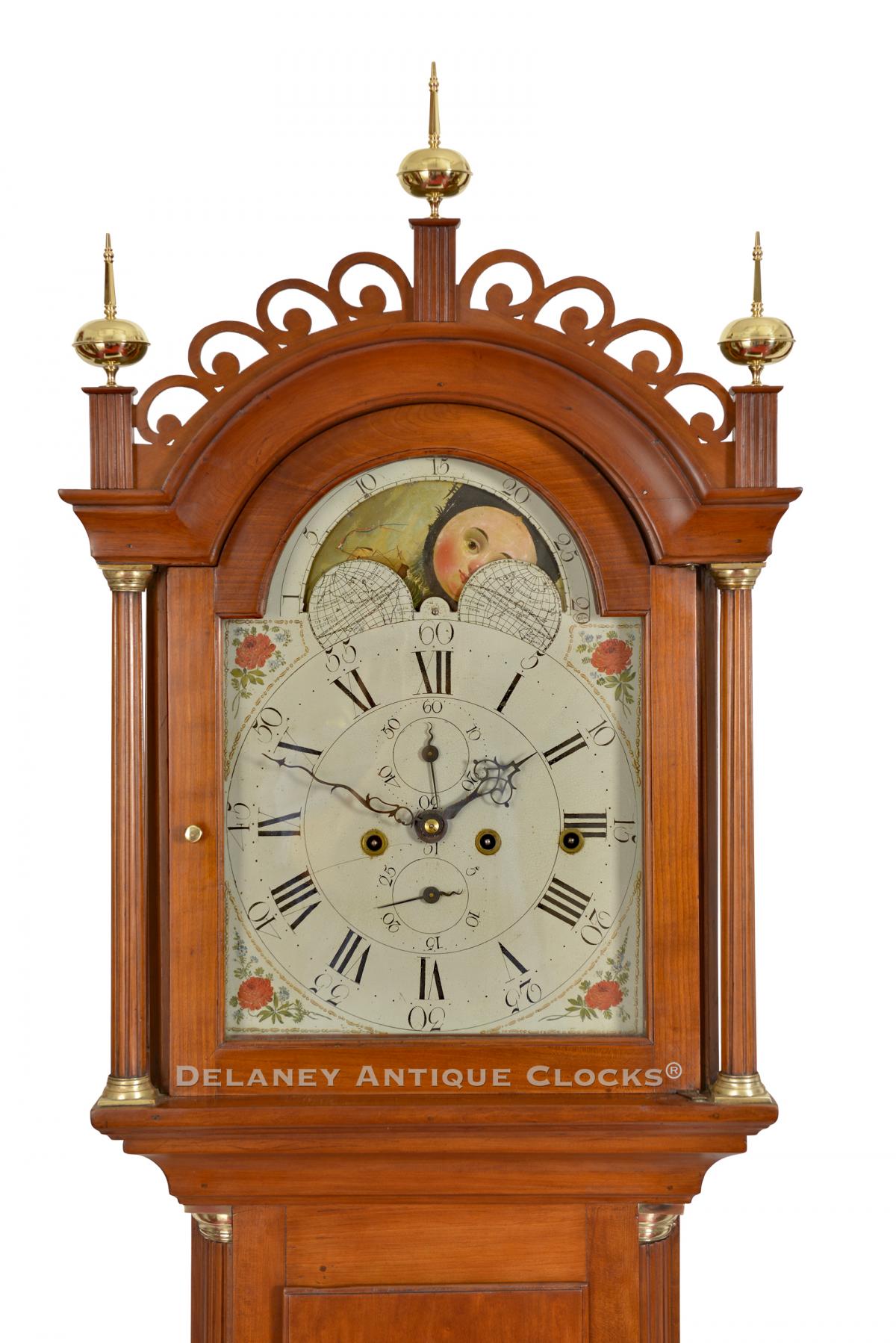A diminutively sized inlaid cherry case tall clock made by John Fairbanks. Only 81 inches tall to the top of the center finial. It features a very unusual three-train movement designed to strike the quarter hours. 223008.
This is a diminutively sized inlaid cherry case tall clock made by John Fairbanks. The case measures only 81 inches tall to the top of the center finial. In addition, it features a very unusual three-train movement designed to strike the quarter hours.
This beautiful cherry case has recently been refinished in an appropriate shellac finish. This surface treatment highlights the wood's warm tones and the grain patterns' subtle details. The case is set on a boldly formed molding that rests flat on the floor. This shaped molding is designed with parallel groves and applied to the bottom of the base. The waist section includes a rectangular-shaped door decoratively inlaid with an oval. The oval features a figured selection of mahogany trimmed with a light line of maple string inlay. The front corners of the waist are fitted with fluted quarter columns that terminate in brass quarter capitals. An open fretwork pattern surmounts the bonnet. The pattern is unusual. Several circular-shaped returns cascade along the arched molding. Three fluted plinths help secure the frets in place. Each plinth supports a brass ball-and-spike finial. The free-standing bonnet columns are fluted and terminate in brass capitals. They visually support the hand-molded arch and are positioned on either side of the arched door fitted with glass.
This dial is of English manufacture and was painted by the Wilson firm of Birmingham. It is skillfully decorated in bright colors and features traditional themes for this period. The four spandrel areas are decorated with floral patterns framed with a gilt border. The time track features Roman hour-style numerals separated from the Arabic five-minute markers by a dotted minute ring. A subsidiary seconds dial, and the calendar date dial is located within the time ring. The steel hands are well formed. The hour hand is an exceptional design. A lunar calendar is featured in the lunette. This is a visual display of the phases of the moon. The painted hemispheres remain in excellent condition.
This fine weight-driven eight-day movement is constructed in brass and is of good quality. This clock has three trains: time, hour strike, and quarter-hour strike. One should notice that the plates are oversized to accommodate the third train. The plates are wider than they are tall. The backplate is engraved with the Clockmaker's name in the lower-left corner, "J Fairbank N 61." This engraving is artistically embellished. It is very unusual to find a tall clock movement signed in this location. Turned pillars join together the two brass plates. Hardened steel shafts support the polished steel pinions, brass gearing, and deadbeat escapement. Both the time and strike winding drums are grooved. The third train barrel is not. It is also much smaller than the other two. On the left is the time train. The time train is in the center. The hour train or hour strike is on the left. A rack-and-snail striking system actuates this. As a result, it will strike each hour on the hour on a cast iron bell that is mounted above the movement. This is a standard arrangement. The right-side train the quarter-hour strike. The third train strikes a single blow on the first quarter on its bell, which is slightly higher in pitch than the hour strike. At the half-hour, it will strike two blows and, on the third, three. The third train does not strike on the hour.
The original tin can weights are still with this clock. The pendulum features a brass-faced bob.
This case measures approximately 81 inches tall to the top of the center brass finial. The bonnet is 20 inches wide and 9.75 inches deep. As a result, it should fit under just about any ceiling.
This clock was made circa 1815.
Inventory number 223008.


















